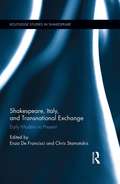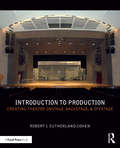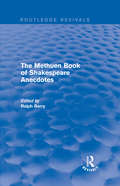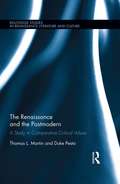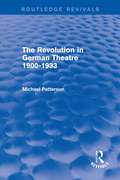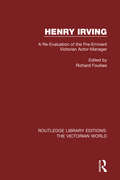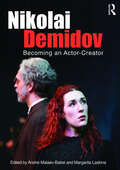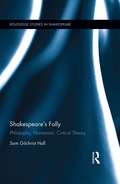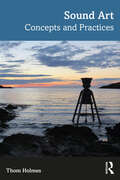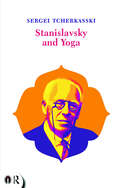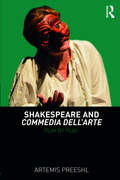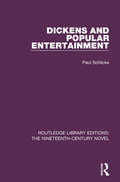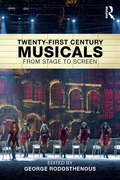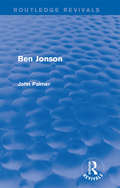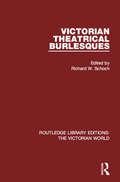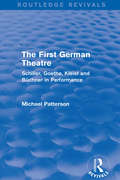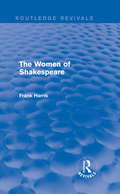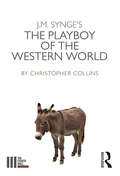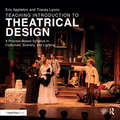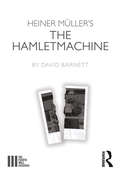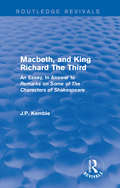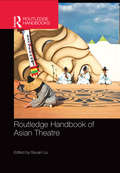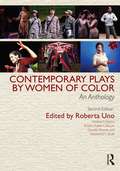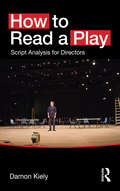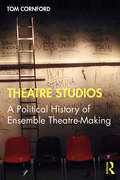- Table View
- List View
Shakespeare, Italy, and Transnational Exchange: Early Modern to Present (Routledge Studies in Shakespeare)
by Enza De Francisci Chris StamatakisThis interdisciplinary, transhistorical collection brings together international scholars from English literature, Italian studies, performance history, and comparative literature to offer new perspectives on the vibrant engagements between Shakespeare and Italian theatre, literary culture, and politics, from the sixteenth to the twenty-first century. Chapters address the intricate, two-way exchange between Shakespeare and Italy: how the artistic and intellectual culture of Renaissance Italy shaped Shakespeare’s drama in his own time, and how the afterlife of Shakespeare’s work and reputation in Italy since the eighteenth century has permeated Italian drama, poetry, opera, novels, and film. Responding to exciting recent scholarship on Shakespeare and Italy, as well as transnational theatre, this volume moves beyond conventional source study and familiar questions about influence, location, and adaptation to propose instead a new, evolving paradigm of cultural interchange. Essays in this volume, ranging in methodology from archival research to repertory study, are unified by an interest in how Shakespeare’s works represent and enact exchanges across the linguistic, cultural, and political boundaries separating England and Italy. Arranged chronologically, chapters address historically-contingent cultural negotiations: from networks, intertextual dialogues, and exchanges of ideas and people in the early modern period to questions of authenticity and formations of Italian cultural and national identity in the eighteenth and nineteenth century. They also explore problems of originality and ownership in twentieth- and twenty-first-century translations of Shakespeare’s works, and new settings and new media in highly personalized revisions that often make a paradoxical return to earlier origins. This book captures, defines, and explains these lively, shifting currents of cultural interchange.
Introduction to Production: Creating Theatre Onstage, Backstage, & Offstage
by Robert I. Sutherland-CohenIntroduction to Production: Creating Theatre Onstage, Backstage, & Offstage defines the collaborative art of making theatre and the various job positions that go into realizing a production. Beginning with an overview of the art and industry of theatre, the book shows how theatre has evolved through history. The book then breaks down the nuts and bolts of the industry by looking at each professional role within it: from the topmost position of the producer down to the gopher, or production assistant. Each of these positions are defined along with their respective duties, rules, and resources that figure in obtaining these jobs. Each chapter offers exercises, links to videos and websites, review quizzes, and suggested readings to learn more about the creation and production of theatre.
The Methuen Book of Shakespeare Anecdotes
by Ralph BerryFew playwrights have been more slandered, abused or honoured in performance than William Shakespeare. First published in 1992, this collection of 300 stories focuses on Shakespeare’s plays on stage. Organised chronologically, it offers the reader the opportunity to witness the changes in theatrical approaches to Shakespeare from their own time to the present day. This book will be of interest to those studying theatre, but also to those fascinated by the Shakespeare tradition.
The Renaissance and the Postmodern: A Study in Comparative Critical Values (Routledge Studies in Renaissance Literature and Culture)
by Thomas L Martin Duke PestaThe Renaissance and the Postmodern reconsiders postmodern readings of Renaissance texts by engaging in a dialectics the authors call comparative critical values. Rather than concede the contemporary hierarchy of theory over literature, the book takes the novel approach of consulting major Renaissance writers about the values at work in postmodern representations of early modern culture. As criticism seeks new directions and takes new forms, insufficient attention has been paid to the literary and philosophical values won and lost in the exchanges. One result is that the way we understand the logical connections, the literary textures, and the philosophical impulses that make up the literature of writers like Spenser, Shakespeare, and Milton has fundamentally changed. Examining theoretical debates now in light of polemical controversies then, the book goes beyond earlier studies in that it systematically examines the effects of these newer critical approaches across their materialist, historicist, deconstructive, and psychoanalytic manifestations. Bringing gravity and focus to this question of critical continuities and discontinuities, each chapter counterposes one major Renaissance voice with a postmodern one to probe these issues and with them the value of the cultural past. As voices on both sides of the historical divide illuminate key differences between the Renaissance and the Postmodern, a critical model emerges from the book to re-engage this period’s humane literature in a contemporary context with intellectual rigor and a renewed sense of cultural enrichment.
The Revolution in German Theatre 1900-1933 (Routledge Revivals)
by Michael PattersonFirst published in 1981, this book represents the first work in English to give a comprehensive account of the revolutionary developments in German theatre from the decline of Naturalism through the Expressionist upheaval to the political theatre of Piscator and Brecht. Early productions of Kaiser’s From Morning till Midnight and Toller’s Transfiguration are presented as examples of Expressionism. A thorough analysis of Piscator’s Hoppla, Such is Life! And Brecht’s Man show the similarities and differences in political theatre. In addition, elements of stage-craft are examined — illustrated with tabulated information, an extensive chronology, and photographs and designs of productions.
Henry Irving: A Re-Evaluation of the Pre-Eminent Victorian Actor-Manager (Routledge Library Editions: The Victorian World #18)
by Richard FoulkesHenry Irving (1838-1905), the first actor to be knighted, dominated the theatre in Britain and beyond for over a quarter of a century. As an actor, he was strikingly different with his idiosyncratic pronunciation, his somewhat ungainly physique, and his brilliant psychological portrayals of virtue and villainy. He was also the director of spectacular, and commercially driven, entertainments and as the manager of the Lyceum theatre, he controlled every aspect of the performance. First published in 2008, this collection of essays by leading theatre scholars explores each element of Irving’s art: his acting, his contribution to the plays he commissioned, his flair for the stage picture, and his ear for incidental music. This book will be of interest to those studying the history of theatre.
Nikolai Demidov
by Nikolai DemidovAt the time of his death, Stanislavsky considered Nikolai Demidov to be ‘his only student, who understands the System’. Demidov’s incredibly forward-thinking processes not only continued his teacher’s pioneering work, but also solved the problems of an actor’s creativity that Stanislavsky never conquered. This book brings together Demidov’s five volumes on actor training. Supplementary materials, including transcriptions of Demidov’s classes, and notes and correspondence from the author make this the definitive collection on one of Russian theatre’s most important figures.
Shakespeare's Folly: Philosophy, Humanism, Critical Theory (Routledge Studies in Shakespeare)
by Sam HallThis study contends that folly is of fundamental importance to the implicit philosophical vision of Shakespeare’s drama. The discourse of folly’s wordplay, jubilant ironies, and vertiginous paradoxes furnish Shakespeare with a way of understanding that lays bare the hypocrisies and absurdities of the serious world. Like Erasmus, More, and Montaigne before him, Shakespeare employs folly as a mode of understanding that does not arrogantly insist upon the veracity of its own claims – a fool’s truth, after all, is spoken by a fool. Yet, as this study demonstrates, Shakespearean folly is not the sole preserve of professional jesters and garrulous clowns, for it is also apparent on a thematic, conceptual, and formal level in virtually all of his plays. Examining canonical histories, comedies, and tragedies, this study is the first to either contextualize Shakespearean folly within European humanist thought, or to argue that Shakespeare’s philosophy of folly is part of a subterranean strand of Western philosophy, which itself reflects upon the folly of the wise. This strand runs from the philosopher-fool Socrates through to Montaigne and on to Nietzsche, but finds its most sustained expression in the Critical Theory of the mid to late twentieth-century, when the self-destructive potential latent in rationality became an historical reality. This book makes a substantial contribution to the fields of Shakespeare, Renaissance humanism, Critical Theory, and Literature and Philosophy. It illustrates, moreover, how rediscovering the philosophical potential of folly may enable us to resist the growing dominance of instrumental thought in the cultural sphere.
Sound Art: Concepts and Practices
by Thom HolmesSound Art offers the first comprehensive introduction to sound art written for undergraduate students. Bridging and blending aspects of the visual and sonic arts, modern sound art first emerged in the early 20th century and has grown into a thriving and varied field. In 13 thematic chapters, this book enables students to clearly grasp both the concepts behind this unique area of art, and its history and practice. Each chapter begins with an exploration of key ideas and theories, followed by an in-depth discussion of selected relevant works, both classic and current. Drawing on a broad, diverse range of examples, and firmly interdisciplinary, this book will be essential reading for anyone studying or teaching the theory, history, appreciation, or practice of sound art.
Stanislavsky and Yoga (Routledge Icarus)
by Sergei TcherkasskiThis book deals with one of the most important sources of the Stanislavsky System - Yoga, its practice and philosophy. Sergei Tcherkasski carefully collects records on Yoga in Stanislavsky's writings from different periods and discusses hidden references which are not explained by Stanislavsky himself due to the censorship in his day. Vivid examples of Yoga based training from the rehearsal practice of the Moscow Art Theatre and many of Stanislavsky's studios (the First Studio in 1910s, the Second Studio and Opera Studio of the Bolshoi Theatre in 1920s, Opera-Dramatic Studio in 1930s) are provided. The focus of Tcherkasski's research consists of a comparative reading of the Stanislavsky System and Yogi Ramacharaka's books, which were a main source for Stanislavsky. Accordingly, Tcherkasski analyzes elements of the System based on Yoga principles. Among them are: relaxation of muscles (muscular release), communication and prana, emission of rays and reception of rays, beaming of aura, sending of prana, attention, visualizations (mental images). Special attention is paid to the idea of the superconscious in Yoga, and in Ramacharaka's and Stanislavsky's theories. Tcherkasski's wide-ranging analysis has resulted in new and intriguing discoveries about the Russian master. Furthermore, he reveals the extent to which Stanislavsky anticipated modern discoveries in neurobiology and cognitive science. In this book Tcherkasski acts as a researcher, historian, theatre director, and experienced acting teacher. He argues that some forty per cent of basic exercises in any Stanislavsky based actor training program of today are rooted in Yoga. Actors, teachers, and students will find it interesting to discover that they are following in the footsteps of Yoga in their everyday Stanislavsky based training and rehearsals.
Shakespeare and Commedia dell'Arte: Play by Play
by Artemis PreeshlShakespeare and Commedia dell’Arte examines the ongoing influence of commedia dell’arte on Shakespeare’s plays. Exploring the influence of commedia dell’arte improvisation, sight gags, and wordplay on the development of Shakespeare’s plays, Artemis Preeshl blends historical research with extensive practical experience to demonstrate how these techniques might be applied when producing some of Shakespeare's best-known works today. Each chapter focuses on a specific play, from A Midsummer Night’s Dream to The Winter’s Tale, drawing out elements of commedia dell’arte style in the playscripts and in contemporary performance. Including contemporary directors’ notes and interviews with actors and audience members alongside Elizabethan reviews, criticism, and commentary, Shakespeare and Commedia dell’Arte presents an invaluable resource for scholars and students of Renaissance theatre.
Dickens and Popular Entertainment (Routledge Library Editions: The Nineteenth-Century Novel #34)
by Paul SchlickeFirst published in 1985. Dickens was a vigorous champion of the right of all men and women to carefree amusements and dedicated himself to the creation of imaginative pleasure. This book represents the first extended study of this vital aspect of Dickens’ life and work, exploring how he channelled his love of entertainment into his artistry. This study offers a challenging reassessment of Nicholas Nickleby, The Old Curiosity Shop and Hard Times. It shows the importance of entertainment to Dickens’ journalism and presents an illuminating perspective on the public readings which dominated the last twelve years of his life. This book will be of interest to students of literature.
Twenty-First Century Musicals: From Stage to Screen
by George RodosthenousTwenty-First Century Musicals stakes a place for the musical in today’s cinematic landscape, taking a look at leading contemporary shows from their stage origins to their big-screen adaptations. Each chapter offers a new perspective on a single musical, challenging populist narratives and exploring underlying narratives and sub-texts in depth. Themes of national identity; race, class and gender; the ‘voice’ and ‘singing live’ on film; authenticity; camp sensibilities; and the celebration of failure are addressed in a series of questions including: How does the film adaptation provide a different viewing experience from the stage version? What themes are highlighted in the film adaptation? What does the new casting bring to the work? Do camera angles dictate a different reading from the stage version? What is lost/gained in the process of adaptation to film? Re-interpreting the contemporary film musical as a compelling art form, Twenty-First Century Musicals is a must-read for any student or scholar keen to broaden their understanding of musical performance.
Ben Jonson (Routledge Revivals)
by John PalmerOriginally published in 1934, Palmer’s biography of famous playwright Ben Jonson delves into his life and works and what he achieved in both. As first poet laureate of England, Jonson’s life presents a fascinating look into the state of literature and theatre in renaissance Britain which Palmer presents in great detail. This title will be of interest to students of literature.
Victorian Theatrical Burlesques (Routledge Library Editions: The Victorian World)
by Richard W. SchochFirst published in 2003. Wildly popular in their own day, Victorian burlesques are now little read, scarcely studied, and never performed. Giving long overdue emphasis to an unjustly neglected theatrical tradition, this critical edition - the first to focus on Victorian burlesques of Victorian plays - represents a valuable scholarly tool for students and scholars of modern drama, theatre history, and nineteenth-century popular culture. Victorian Theatrical Burlesques includes a 'state-of-the-art' introduction which provides a general overview of theatrical burlesques in the Victorian era, emphasising performance history. Sustained reference is made to burlesques other than those presented in the anthology. Through its general introduction, prefaces and annotations to individual plays, checklist of burlesque plays, and bibliography, the unique volume allows both specialist and non-specialist readers to see Victorian burlesques as a rich historical record of shifting attitudes toward drama and the theatre.
The First German Theatre (Routledge Revivals): Schiller, Goethe, Kleist and Büchner in Performance
by Michael PattersonFirst published in 1990. The book surveys of the development of German theatre from a market sideshow into an important element of cultural life and political expression. It examines Schiller as ‘theatre poet’ at Mannheim, Goethe’s work as director of the court theatre at Weimar, and then traces the rapid commercial decline that made it difficult for Kleist and impossible for Büchner to see their plays staged in their own lifetime. Four representative texts are analysed: Schiller’s The Robbers, Goethe’s Iphigenia on Tauris, Kleist’s The Prince of Homburg, and Büchner’s Woyzeck. This title will be of interest to students of theatre and German literature.
The Women of Shakespeare (Routledge Revivals)
by Frank HarrisFrank Harris argues that the way women are presented in Shakespeare’s plays and sonnets are a reflection of the real-life women in his life, namely his wife, mother, mistress and daughter. Originally published in 1911, The Women of Shakespeare also analyses the traditional criticism of the time and places his own views in this context. This title will be of interest to students of English Literature.
The Playboy of the Western World (The Fourth Wall)
by Christopher Collins‘I’m thinking this night wasn’t I a foolish fellow not to kill my father in years gone by.’ – Christy Mahon On the first night of J. M. Synge’s The Playboy of the Western World (1907) the audience began protesting in the theatre; by the third night the protests had spilled onto the streets of Dublin. How did one play provoke this? Christopher Collins addresses The Playboy ’s satirical treatment of illusion and realism in light of Ireland’s struggle for independence, as well as Synge’s struggle for artistic expression. By exploring Synge’s unpublished diaries, drafts and notebooks, he seeks to understand how and why the play came to be. This volume invites the reader behind the scenes of this inflammatory play and its first performances, to understand how and why Synge risked everything in the name of art.
Teaching Introduction to Theatrical Design: A Process Based Syllabus in Costumes, Scenery, and Lighting
by Eric Appleton Tracey LyonsTeaching Introduction to Theatrical Design is a week-by-week guide that helps instructors who are new to teaching design, teaching outside of their fields of expertise, or looking for better ways to integrate and encourage non-designers in the design classroom. This book provides a syllabus to teach foundational theatrical design by illustrating process and application of the principals of design in costumes, sets, lights, and sound.
Heiner Müller's The Hamletmachine (The Fourth Wall)
by David Barnett"I’m good Hamlet gi’me a cause for grief" At first glance, readers of The Hamletmachine (1979) could be forgiven for wondering whether it is actually a play at all: it opens with a montage of texts that are not ascribed to a character, there is no vestige of a plot, and the whole piece lasts a total of ten pages. Yet, Heiner Müller’s play regularly features in theatres’ repertoires and is frequently staged by university theatre departments. In four short chapters, David Barnett unpicks the complexities of The Hamletmachine’s writing and frames its author as an experimental, politically committed writer who confronts the shortcomings of his age. In considering the problems Müller poses for the play’s performance, he also discusses two exemplary productions in order to show how the work can engage very different audiences. This book examines why such a compact, radically open, and yet seemingly obscure play has proved so popular.
Macbeth, and King Richard The Third: An Essay, In Answer to Remarks on Some of The Characters of Shakespeare (Routledge Revivals)
by J.P. KembleJohn Philip Kemble was an ambitious and successful stage actor in London, perhaps most well-known for his turn as Shakespeare’s Macbeth. Kemble passionately disagreed with the posthumous work of Thomas Watley, Remarks on Some of the Characters of Shakespeare (1785), particularly Watley’s representations of some of Shakespeare’s greatest villains, Richard III and Macbeth. This title, first published in 1786 (this reprint of the second edition first published in 1970), presents Kemble’s nuanced criticisms of the characters leaving the impression that the villainies of Macbeth and Richard III are indeed similar. A historically important literary reaction, this title will be of interest to students of English literature and literary criticism.
Routledge Handbook of Asian Theatre
by Siyuan LiuRoutledge Handbook of Asian Theatre is an advanced level reference guide which surveys the rich and diverse traditions of classical and contemporary performing arts in Asia, showcasing significant scholarship in recent years. An international team of over 50 contributors provide authoritative overviews on a variety of topics across Asia, including dance, music, puppetry, make-up and costume, architecture, colonialism, modernity, gender, musicals, and intercultural Shakespeare. This volume is divided into four sections covering: Representative Theatrical Traditions in Asia. Cross-Regional Aspects of Classical and Folk Theatres. Modern and Contemporary Theatres in Asian Countries. Modernity, Gender Performance, Intercultural and Musical Theatre in Asia. Offering a cutting edge overview of Asian theatre and performance, the Handbook is an invaluable resource for academics, researchers and students studying this ever-evolving field.
Contemporary Plays by Women of Color: An Anthology
by Roberta UnoIn the two decades since the first edition of Contemporary Plays by Women of Color was published, its significance to the theatrical landscape in the United States has grown exponentially. Work by female writers and writers of color is more widely produced, published, and studied than ever before. Drawing from an exciting range of theaters, large and small, from across the country, Roberta Uno brings together an up-to-date selection of plays from renowned and emerging playwrights tackling a variety of topics. From the playful to the painful, this revised and updated edition presents a rich array of voices, aesthetics, and stories for a transforming America.
How to Read a Play: Script Analysis for Directors
by Damon KielyThe work done on a play before the first rehearsal, the first group reading or even the before the cast have met, can be crucial to the success of a production. Directors and dramaturgs must know how to analyze, understand and interpret a play or performance text if they hope to bring it to life on the stage. This book provides a broad range of tools and methods that can be used when reading a text, including: Lessons from the past. What can we learn from Aristotle, Stanislavsky, Meyerhold, Vakhtangov, Brecht and Harold Clurman? This section establishes the models and methods that underpin much of a director’s work today. A survey of current practices in Western theatre. A combination of research, interviews and observation of practical work addresses the main stages in understanding a play, such as getting to know characters, sharing ideas, mapping the action and grappling with language. A workbook, setting out twenty one ways of breaking down a play, from the general to the particular. Contributions, reflections and interjections from a host of successful directors make this the ideal starting point for anyone who wants to direct a play, or even devise one of their own. This wide range of different approaches, options and techniques allows each reader to create their own brand of play analysis.
Theatre Studios: A Political History of Ensemble Theatre-Making
by Tom CornfordTheatre Studios explores the history of the studio model in England, first established by Konstantin Stanislavsky, Jacques Copeau and others in the early twentieth century, and later developed in the UK primarily by Michel Saint-Denis, George Devine, Michael Chekhov and Joan Littlewood, whose studios are the focus of this study. Cornford offers in-depth accounts of the radical, collective work of these leading theatre companies of the mid-twentieth century, considering the models of ensemble theatre-making that they developed and their remnants in the newly publicly-funded UK theatre establishment of the 1960s. In the process, this book develops an approach to understanding the politics of artistic practices rooted in the work of John Dewey, Antonio Gramsci and the standpoint feminists. It concludes by considering the legacy of the studio movement for twenty-first-century theatre, partly by tracking its echoes in the work of Secret Theatre at the Lyric, Hammersmith (2013–2015). Students and makers of theatre alike will find in this book a provocative and illuminating analysis of the politics of performance-making and a history of the theatre as a site for developing counterhegemonic, radically democratic, anti-individualist forms of cultural production.
